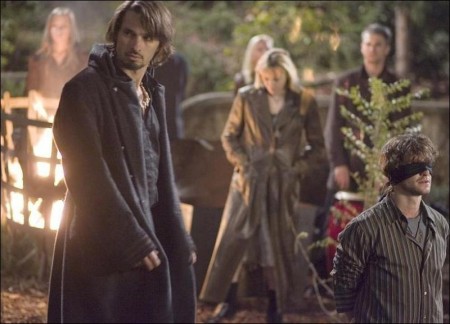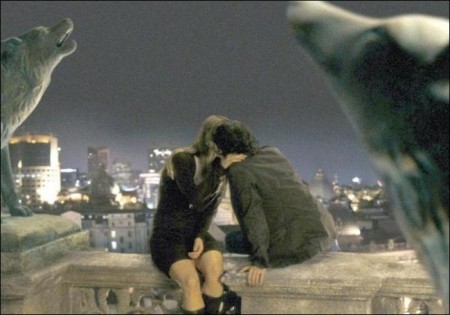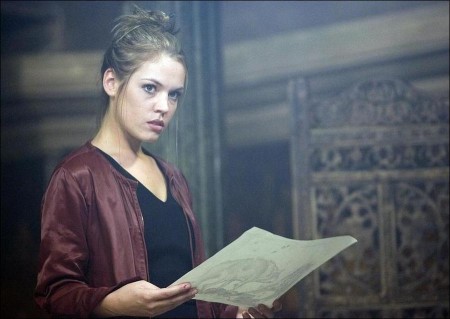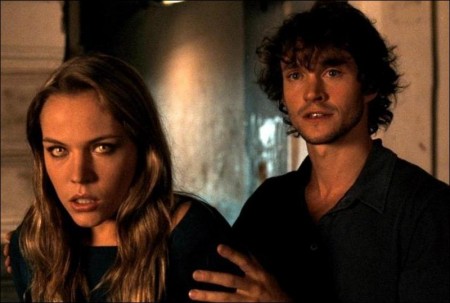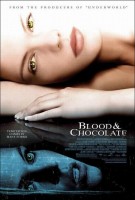Tagline: Temptation comes in many forms.
“Blood and Chocolate” is based on Annette Curtis Klause’s novel about a teenage werewolf who has spent her life trying to hide the fact that she is part wolf. She must choose between her love for a human and her family after her relationship with a visiting American threatens to expose her secret.
“Blood and Chocolate” stars Agnes Bruckner (“24”), Hugh Dancy (“Basic Instinct 2,”) and Olivier Martinez (“Taking Lives”) and is directed by German independent film director Katja von Garnier (“Bandits”).
The story takes place in modern day Bucharest and tells the tale of nineteen year old Vivian Gandillon (Bruckner), who has spent her life on the run from the truth… that she is a werewolf. When her affections for a visiting American artist threaten to expose her family’s secret society, she must choose between her love for an outsider and betraying the secret vows of her family.
Ten years ago, in the remote mountains of Colorado, a young girl watched helplessly as her family was murdered by a pack of angry men for the secret they carried in their blood. She survived by running into the woods, and changing into something the hunters could never find… a wolf. Now, though she lives half a world away, Vivian Gandillon (Agnes Bruckner) is still running.
Living in relative safety in Bucharest, Vivian spends her days working at a chocolate shop and nights trawling the city’s underground clubs, fending off the reckless antics of her cousin Rafe (Bryan Dick) and his gang of delinquents he calls “The Five.” But only when she’s running through the woods around the city does Vivian feel truly free… though whatever she’s chasing seems continually to elude her.
Aiden Galvin (Hugh Dancy) is an artist researching Bucharest’s ancient art and relics for his next graphic novel based on the mythology of the loup garoux – shapeshifters whose power to change effortlessly into the forms of both human and wolf was once considered holy among men.
Wrestling demons of his own, Aiden hopes to explore the inner lives of these outsiders that he believes were persecuted to extinction – labeled monsters, murderers, werewolves. They achieved what he lacks – transcendence, the ability to change what they are. What he doesn’t know is that the loup garoux are not only very real, they’re far from extinct.
Others may have secrets but none as extraordinary as hers, for Vivian is among the last of her kind, leading a tenuous existence under the protection and control of Gabriel (Olivier Martinez), the powerful and enigmatic leader of one of the last packs of loux garoux on earth. After their brief exchange in the church, Aiden can’t get Vivian out of his mind, nor can she forget him. He pursues her until she relents and begins to see him, but she can’t bring herself to tell him the truth – and lives in fear of showing him what she really is. If she bleeds, her eyes will betray her as a loup garoux. And what’s worse: her future, and who she falls in love with, is already predetermined.
To keep their kind from being hunted to extinction, Gabriel holds them to strict laws. One is that he must take a new bride every seven years, and Vivian has been prophesied to be his next. The other is that the pack must hunt as one or not at all. It is the very key to their survival. Chased from the soil of every continent, only in Bucharest – where once a Magyar prince was said to have loup garoux blood – have they found sanctuary.
On the night of the full moon, they gather as one in the woods outside the city. Though the wolves are outnumbered by man, on the night of the hunt, they can be who they truly are – hunting a single chosen human as a pack. If their prey reaches the other side of the river, he will be allowed to live… but no human has ever reached the river. Though Vivian has sworn never to kill, she is as much animal as she is human, and her love for Aiden threatens to cast him to the very wolves who saved her life… and who are waiting for their chance to hunt him as prey. And the full moon is almost upon them.
About the Production
“In fear I hurried this way and that. I had the taste of blood and chocolate in my mouth, the one as hateful as the other.” — Hermann Hesse, Steppenwolf
Werewolves have been known by various names – shapeshifters, succubi, demons… and loup garoux. An outgrowth of mythology as old as civilization itself, tales of werewolves and shapeshifters have cropped up around disappearances, murders, violence and death throughout history. “They express fear of the unknown,” notes director Katja von Garnier, “but more than that, they express fear of the unknown within the known – the hidden predator living undetected amongst humanity, the hidden animal within the man.”
“I think that everybody is fascinated by them,” says cast-member Bryan Dick. “I don’t think there’s a person who has not watched a werewolf film or been interested in the fantasy of shapeshifters and that kind of moonlight world. It’s very appealing and it’s also very sexy.”
“If you examine most of the myths, particularly the myths we consider the horror myths — werewolves, vampires — it probably is an expression of the fact that we all potentially have some sort of monster within us, something that doesn’t fit with the civilized world,” adds cast-member Hugh Dancy.
The story of “Blood and Chocolate” explores this idea through a star-crossed love story. “It really is about these people just trying to fit in and survive in the modern civilized world,” says Agnes Bruckner. “Hopefully we haven’t done an injustice to the myths as they stand; we’ve just reinvented them and given them a new twist.”
Bruckner plays Vivian Gandillon, a headstrong young woman who “comes from a long line of leaders,” says Bruckner. “Her pack has plans for Vivian, but her blood has always told her not to go their way. She lives among them for protection and because they took her in after her family was slaughtered, but she is not exactly one of them.”
This pack of loup garoux is led by Gabriel, who despite his youthful appearance is perhaps as ancient as he is powerful. Close to extinction, the werewolves must maintain their close-knit ways to persist beneath humanity’s detection. “Gabriel’s driving concern is the survival and unity of the pack,” says producer Hawk Koch.
“Having already witnessed what happened to those who strayed, such as Vivian’s family – who relocated to Colorado only to be tracked and murdered by the hunters who discovered their identity – Gabriel will do anything in his power to ensure the survival of his loup garoux in Romania.”
Vivian is marked for marriage to Gabriel because he can see plainly her urge to stray away from the pack. “She’s not from the pack,” says Martinez. “She was raised by our pack but she doesn’t really belong to it. She doesn’t think that she belongs to any kind of society. She’s free. And Gabriel knows that if Vivian leaves the pack, it’s going to be the beginning of the end. It would be anarchy and would create an example, which would endanger the unity that has kept them alive.”
As is their custom, every seven years the leader of the pack picks a new mate. This time Gabriel picks Vivian. “She represents a new point of view about the rules and the traditions and my character is sticking with tradition because he thinks this is the only way to survive,” Martinez explains. “Gabriel thinks that she is betraying the cause by resisting. He witnessed the old way and believes that the loup garoux have to kill or be killed.”
Vivian lives with her Aunt Astrid (Katja Riemann), one of Gabriel’s former mates, who is still heartbroken that he moved on after their affair. “The ways of the pack are not always fair,” says Riemann. This notion is embodied by Astrid, who bore Gabriel’s child – Rafe (Bryan Dick). Though Vivian is forced to be among them, she has nothing but contempt for Rafe and his friends, “The Five,” who insist on breaking the one cardinal rule devised to keep them all safe from humans: “hunt as a pack or not at all.”
Dick says, “The Five are the new generation of the wolf pack and as such they pay little regard to the rules. They bend them whereas Rafe breaks them entirely. I think that’s what the film’s about, ultimately. It’s about an exiled community which is struggling to keep together a code of conduct which doesn’t quite work.”
Once a month Gabriel sanctions the pack’s killing of a human in the form of a ritualistic hunt held in the Romanian forest under the auspices of the full moon. Vivian attends, but not for the hunt. “It’s not the actual kill,” says Bruckner. “It’s the running she craves, and the werewolf side it brings out. It’s always in her and she loves that side of herself but she doesn’t want to show it in everyday life.”
“Vivian resents and resists the animal part of herself,” adds von Garnier. “She dislikes the current regime of the loup garoux that’s based on hatred and revenge.”
Vivian’s unexpected encounter with the young American artist Aiden throws a wrench in Gabriel’s plans for her. Fascinated with the legends of loup garoux, Aiden has come to Bucharest to research the legends at their nexus. “Vivian is surprised by Aiden’s passion for wolves and loup garoux,” says von Garnier.
Although their backgrounds are wildly divergent, Vivian and Aiden do have one thing in common: they are both on the run from familial expectations. “Aidan is a guy who is also running from something in the same way that Vivian is,” says Hugh Dancy.
“She has this terrible past – she lost her family – and she’s not necessarily comfortable with the community she’s with now. Aidan is also on the run from something. He has a bit of mystery and secrets from his own past, which he’s withholding.”
“Vivian is going through a point where she wants to be human but also likes the wolf side of her, but not the violence associated with it,” adds Bruckner. “When she meets Aiden, she sees herself in him a little bit – the side that she really loves. It draws her to him.”
When Gabriel learns of Vivian’s interest in a human – in his eyes the ultimate betrayal of the pack – he dispatches Rafe to threaten Aiden into leaving both Bucharest and Vivian behind. Despite Rafe’s supernatural advantages, Aiden surprisingly proves himself capable of taking on a loup garou. “He may be an artist, but when a wolf jumps on him he can take care of himself,” Dancy says.
But his resistance only urges Gabriel to more extreme measures. As Vivian and Aiden begin to fall in love, the shadow of her heritage edges ever closer. “Vivian knows that whatever love develops between them will have to be short-lived,” says Bruckner. “Every moment Aiden spends with her not only throw the pack into chaos, it puts his life, and hers, in great danger.”
Love in the underground of Bucharest
Lakeshore Entertainment producers Tom Rosenberg and Gary Lucchesi partnered with acclaimed screenwriter Ehren Kruger (“The Ring”) to adapt Annette Curtis Klause’s beloved young adult novel Blood and Chocolate for the screen. To bring this story to life, they approached young German director Katja von Garnier (“Bandits”), whose sensibility matched the tale of impossible love in the underground of Bucharest.
“This is a story about two people from opposite worlds who fight to be together, very much like Romeo and Juliet, except that our Juliet belongs to a group of people who are shapeshifters, people who can transform into wolves,” explains von Garnier. “I responded to the drama of an ancient, once glorious culture, facing extinction due to being hunted by man. Working with wolves was also another determining factor.”
Veteran producer Hawk Koch next signed on as creative producer at the behest of long-time colleague Lucchesi and also found that the material was uniquely suited to von Garnier. “Katja has passion and a deep love for wolves, which gave her a completely unique take on this story,” he says. “She believed in this transformation and in this spiritual place where this movie takes us.”
The director at once felt simpatico with the filmmaking team already assembled. “One of Hawk’s many strengths as a producer is being able to balance the creative vision with production needs,” comments von Garnier. “He is a force and I am grateful to have had him on my side. We had a great experience together.”
The filmmakers cast up-and-coming American actress Agnes Bruckner as Vivian, who sought to bring the “softer side” to the legend of the werewolf. “I think it is beautiful to express that side of this legend,” she says. “Werewolves are always thought of as these scary creatures but I think that this movie really shows that there is a whole other side of them. Wolves themselves are not evil – neither are loup garoux.”
The young actress impressed von Garnier with her sensitivity wrapped in toughness. “She has wisdom far beyond her years,” says the director, “and understood the role perfectly. During the shoot, it was impressive to watch how she would always save something for her close up. Even after 10 hours into the day, she still had something in store for us when it came to her close up. She is very gifted.”
Koch adds, “Agnes has such amazing talent that all of us who are fortunate enough to work with her early in her career will be able to watch her career grow. She is a consummate actress even at 20 years old.”
British actor Hugh Dancy took on the role of Aiden, the human interloper in the secret society of werewolves. “What any love story rides on is the chemistry of the lead characters,” comments von Garnier. “We have been blessed with great chemistry between Agnes and Hugh. Hugh enriched the part of Aiden with his sense of wonder, depth, and intelligence that is unique to him.”
The filmmakers consider the casting of Olivier Martinez to be the linchpin of the romantic triangle formed in the film. From their first meeting, Lucchesi, von Garnier and the renowned French actor were very much in synch. Martinez recalls, “For me it was obvious from the beginning how interesting the project was.”
“Olivier is like a wolf,” says the director. “He looks like one and his spirit is like one. That became apparent when Gary (Lucchesi) and I first met him. These characteristics contributed a great deal to the film. We soon realized he was the only person we could imagine playing the leader of the loup garoux.“
At its core, von Garnier believes “Blood and Chocolate” is a love story wrapped in a thriller. “Even though the film has its frightening moments, it’s not specifically a horror film,” she comments. “In werewolf movies, often their transformation is a type of curse. In our movie, the transformation is something liberating and beautiful in nature. Also, the end result is a real wolf, not a fictitious beast.”
Martinez comments, “It’s a werewolf movie but it’s not a werewolf movie. It’s about love, nature – what is the relationship between nature and civilization and whether they can coexist. It seems like it’s quite impossible so far.”
On the same note, Koch offers, “There is fear and excitement in this film but I think there’s also a morality that has universal relevance.”
Whether a testament to the duality of human nature or simply the need to believe in something beyond our everyday existence, a fascination with werewolves and wolf lore has existed throughout the ages and has manifested itself in various forms from ancient Paleolithic paintings to modern-day horror film and comic books. As many of these legends originated in Romania and a wealth of wolf iconography is still highly visible in its art and architecture, the filmmakers found their ideal location for “Blood and Chocolate” in Bucharest itself.
Filming entirely on location in the city and its environs, the filmmaking team was able to capitalize on the city’s unique amalgam of modern and ancient architectural styles and the very best of its many striking locations. “It’s been great filming in Bucharest,” says Hugh Dancy. “It’s like a character in the movie. It’s a luxury to be able to make the most of the city as it exists today as opposed to being on location somewhere without this rich history. It’s very interesting that a lot of those wolf legends come from this part of the world.”
Sharing the character’s fascination, von Garnier conducted extensive research on the subject and then shared her findings with cast and crew alike. “I put material together on the mythical, mystical and symbolic nature of the wolf in hopes of drawing upon them in different ways,” she explains. “I wanted to incorporate aspects of wolf-like behavior with them as humans. The way they move, the way they think.”
From the project’s inception, the filmmakers were intent upon avoiding a negative depiction of the loup garoux and the obvious trappings of the horror genre. “I thought it was important to break with the cliché of the big bad wolf,” says von Garnier. “Wolves really have terrible PR — they are assumed to be these bloodthirsty creatures when they are really quite the opposite. They are shy and intelligent creatures. They are graceful. So it was important to me in dealing with the loup garoux that they were not portrayed in just a negative light.”
Von Garnier decided that the members of the wolf pack should be seen to transform into actual wolves rather than into computer-generated were-creatures. “I thought it would be beneficial to shoot with real wolves,” she says. “They infuse the film with a spirit we would have never gotten from a CG wolf. They embody something that can’t be brought to life on a computer.”
Koch relished the opportunity to bring the natural world into a supernatural tale. “This film is not a visual effects film,” he says. “In the transformations there’s a slight visual effect but it’s humans turning into real wolves. The wolves themselves are the effect.”
One of the most crucial elements in this complex transformation process was the involvement of Hungarian wolf trainer Zoltan Horkai and his sizable wolf pack. von Garnier raves, “Zoltan is incredible – he is a very special human being and an exceptionally gifted trainer.”
The director was adamant that the wolves which were so crucial to the story be treated with dignity, which made Horkai the ideal collaborator. “Zoltan ‘motivates’ his wolves and the outcome is extraordinary,” she says. “There is just so much love between the animals and him. One of the moments I’ll never forget was when I first stood outside his wolf holding area and he started howling and 25 wolves howled back in response. It was an amazing experience.”
To ready themselves for their roles as loup garoux and the numerous physical demands of the transformation sequences, cast members not only trained extensively on harnesses and flying rigs with the stunt team, as led by stunt coordinators Gary Powell and Franklin Henson, but also attended “wolf camp” wherein they were introduced to the wolves and were familiarized with their key patterns of behavior by Horkai.
Wolf Camp consisted of scene rehearsals, breathing techniques, stunt training for the transformation jumps, and physical and psychological training to engage in the ‘wolf mindset.’ “Another central aspect of Wolf Camp was to actually spend time with real wolves as the actors needed to get familiar with the animals,” says von Garnier. “More importantly, the wolves had to get familiar with the actors. Wolves are very shy. Gaining their trust was paramount if the scenes were to work. To give you an example, Hugh Dancy went walking with the main wolf every day in costume, so it could familiarize itself with him.”
Dancy may not play a wolf in “Blood and Chocolate,” but his character spends a large part of the film being pursued by the wolf pack. “Although I didn’t have to prepare to be a wolf, I had to spend a lot of time working and playing with the wolves that we’ve got here,” recalls Dancy. “If you have a wolf jumping off a six-foot platform and basically onto your head, that takes a bit of getting used to,” he deadpans.
“When we started to do this job, some of the actors were curious and some were afraid,” recalls Horkai. “They didn’t know what was in store for them but the first time that our wolf Maya jumped on Olivier Martinez, and also on Hugh Dancy, they were so happy. You could tell that they were just really having fun, that this was not a job for them; it was something new.”
“It’s been very demanding and not just in the acting,” attests producer Koch. “All of the cast has had to get very physical.”
At the behest of director of photography Brendan Galvin, von Garnier drew additional inspiration from the physical discipline of “Free Running” – a French-derived technique of intuitive running whereby runners pass obstacles in the fastest and most direct manner possible, be it jumping, vaulting or climbing. “Free running is all about the elegance of movement that was very fitting for those who can transform into wolves,” says von Garnier. “It proved to be a really interesting and visually attractive way in dealing with the high agility movement and stunts. We even ended up casting one of our Free Runners (John “Kirby” Kerr who plays Finn) as a pack member.”
The filmmakers turned to London VFX house Framestore and VFX supervisor Thomas Tannenberger to execute the transformation concept – characterized as a “leap of faith.” “Katja always imagined the loup garoux as leaping forward not just physically but mentally as well,” observes Dancy. “Obviously the biggest leap of faith is that Vivian and Aiden decide that they can feasibly be together.”
“We needed something to get the point across that it takes physical energy and an effort of the mind to make the change,” explains Tannenberger. “Over a few weeks we developed the concept of a leap – a leap through space and also in our case a leap from one dimension to another, from human to wolf.”
The filmmakers came up with some innovative technical solutions, namely the world’s fastest motion control camera rig which raced along an 80-meter track in the studio and enabled them to follow individual wolves running along as they ran and jumped through the forest set. “It also enabled us to repeat those camera movements, which was crucial, because we were placing actors and stunt people in the exact locations where we had seen the wolves before in order to make the transitions look smooth, organic and as realistic as possible,” explains Tannenberger.
“Putting together a strategy and design for these striking visuals of humans running through what seems to be a giant forest and then turning immediately into wolves was, of course, a coordinated effort,” says Tannenberger.
Humans and wolves would need to hit exact marks to enable the visual effects team to design a smooth transition. “You have to have an actor do a portion of the transformation and the wolf has to finish the transformation,” says Koch. “Well, actors can hit exact marks but with wolves it’s not that easy.”
The techniques and camera rigs used by the filmmakers afforded them a degree of flexibility even with regard to the nature of individual transitions. Special effects supervisor Nick Allder put together a camera rig for that particular purpose. “It has also given us the opportunity to race our cameras along the ceiling of the studio so we can follow the action from above,” says Tannenberger.
The expertise of stunt coordinators Powell and Henson was crucial not only to the transformation scenes but also in the action-packed fight scenes between Aiden and Rafe in the Silestru Chapel and the final showdown in the Absinthe Distillery. “Gary Powell and Franklin Henson are two terrific stunt coordinators,” says Koch. “I’ve worked with some of the best in Hollywood and they rank right up there with some of the guys that I’ve been working with over the last forty years.”
Placing the film in Bucharest informed every aspect of the overall look of the film. Director of photography Brendan Galvin was intrigued by von Garnier’s unique approach to the project and her intention to avoid the obvious elements that the audience usually associates with a supernatural-oriented film, even as it relates to lighting. “Instead of heavy backlit blue light in the night scenes in Bucharest, we wanted a warmer effect and decided that even the moonlight in the forest should have a slightly green hue,” he comments. “We avoided any excessive camera trickery.”
Kevin Phipps, who has worked as an art director on some of the most stylistically distinct films of all time, crafted a world of shadow and muted color for the wolves to inhabit. “He is one of the best art directors in the business and this is his first job as production designer,” says Koch. “The sets he created on this film were simply spectacular.”
Phipps was able to use the visual richness of existing locations in Bucharest to the production’s advantage in many instances. He transformed a former heating plant into the Brookwood Absinthe Distillery, which serves as Gabriel’s lair and created the Dacian Club by modifying a derelict half-finished concrete structure: Ceaucescu’s (the former leader of Communist Romania) Biblioteca Nationala (the National Library). Dancy attests to the seamless integration of Phipps’s sets with the city itself. “The attention to detail is such that the sets fit in perfectly with the city as it really is.”
The filmmakers’ urgent need to provide a secure shooting environment for the wolves as well as for the cast and crew resulted in Phipps’s greatest challenge: the creation of several naturalistic forest sets, including a creek and a river, on MediaPro’s soundstages.
Phipps and his team rose to the challenge by using some 2000 cubic meters of soil, 50-60 real trees along with some polystyrene and fiberglass trees to reproduce a Romanian forest so authentic that it soon attracted its own mosquitoes, lizards as well as a resident owl. He recalls, “The first time we had a show-and-tell on that forest set, suddenly I looked up and there was an owl flying around in the canopy of our trees. Katja looked up and saw the owl and said ‘Kevin, you know that’s a really good sign that we’ll be really happy shooting on this set.’”
Once the creek and river sets were conceived, Phipps worked closely with SFX supervisor Allder on the mechanics, the water system, the pumping system, the filtration and the volume of water that would bring the sets to life.
The filmmaking team had already previsualized the world of the film using small scale models. “You can get down and get your lens into the model and really see how the set is going to shoot and what will be in each frame,” explains Phipps. “This approach was especially useful given the amount of running in the film. Everybody knew what they were getting – stunts, camera, lighting, even the actors.”
Production notes provided by Metro Goldwyn Mayer.
Blood and Chocolate
Starring: Agnes Bruckner, Hugh Dancy, Olivier Martinez, Katja Riemann, Bryan Dick, Chris Geere, Tom Harper, John Kerr, Jack Wilson, Vitalie Ursu, Kata Dobó
Directed by: Katja von Garnier
Screenplay by: Ehren Kruger
Release Date: January 26th, 2007
MPAA Rating: PG-13 for violence / terror, sexuality, substance abuse.
Studio: Metro Goldwyn Mayer
Box Office Totals
Domestic: $3,526,847 (55.9%)
Foreign: $2,784,270 (44.1%)
Total: $6,311,117 (Worldwide)
